|
The unquestionable safe life of vinyl coated SS lifelines expired on many SJ23s some 30 years after manufacture. Surprised? Read on. CORROSION - The problem with vinyl coated SS wire is that there is no way to gauge the quality or strength after the vinyl coating has cracked. Over the years the vinyl will develop cracks that lead to water intrusion and then UV corrosion. Consider that it took 30-40 years for industry and race committees to come to this conclusion. Their realization and guidance happened after several crew members separately broke through their life line and died during early 2020s ocean races. As a result many ocean race committees now consider vinyl coated SS wire unsafe and no longer allow it.
At a glance a person might judge the aging wire to be strong enough to keep them on deck, but a closer inspection will likely reveal many flaws. Granted a crew on a fresh water SJ23 is more likely to trip over a low lifeline than to break it but you should heed the advice of these committees. Just like the
service life of standing rigging in the southern US is ~10 years, so should a life line have a shorter life. Panache's 40 year old life lines in Canada have many cracks and are due for replacement. Corrosion just takes longer in the north. Ah the impressions of guestimating (my SWAG).
- Dyneema does not corrode but has a definitive life when exposed to UV light. But it is a lot stronger and softer making it ideal for lifeline. WEAR - Then there is the wear with vinyl coated SS
wire passing through the 3/8" hole in each stanchion. It looks ugly and has a nasty habit of snagging things. The vinyl coating and then the wire will wear at each post, especially if the line is left drooping so it can swing sideways with the hull.
A lifeline should be tensioned to just snug, no more and no less. Hopefully the tube through the stanchion is smooth with slightly rounded corners.
- Dyneema must be protected against chafe where it goes through a stanchion. This can take the form of lacing twine, a vinyl tube, or any other tough but smooth material.
AVAILABILITY - There are fewer companies that manufacture vinyl coated SS wire these days due to the lower demand from liability issues associated with corrosion.
SS Wire
- It is fair to mention that it is perfectly legit to replace the vinyl coated wire with bare stainless steel wire. Its just that the bare wire is thinner and therefore more likely to cut.
Dyneema
- Today there is a solution in the form of soft Dyneema line. 6MM (1/4") Dyneema is perfect for an SJ23 and is available at most any chandler. It is slightly thicker than the factory SS wire and far exceeding the strength. The thicker Dyneema is easier to rest against.
SAFETY - It has been stated that a safety advantage for a Dyneema lifeline is the ability to cut it with a sharp knife. Opening the lifeline makes it more easily to pull a person onboard from the fore deck since the life line blocks you when reaching for the casualty. It is next to impossible to pull a casualty through the 16" gap below the line. Go ahead, try cutting the SS wire! For the 3 times I have extracted a casualty from the water, it was always done into the cockpit. Lower freeboard, standing closer to the water and operating Panache solo.
Factory Configuration
-
The factory SJ23 life line configuration must be released with the single pelican hook at the transom. This is handy only if there is a crew in the cockpit. Both lines would go slack or certainly droop lower. Without that cockpit crew it is an instant justification to install a Dyneema life line that can be cut.
Net
- On Panache the forward 3/4s of the SS life line is locked permanently with the bow section equipped with a criss-cross of lines to keep a jib on deck. Lots of SJ23s are configured with netting like this. There is no way I can lower the forward SS line nor could I pull a person on board below it. That leaves a cockpit gate as the only place to pull a casualty onboard. The freeboard is lower and I'd be more stable on the cockpit seat to pull the heavy casualty on board. There is a lot to be said for doing this.
Comfort
-
1/4" SS lifeline is painful to lean against for any length of time, less so with thicker Dyneema that can flatten somewhat with body pressure. However, even with Dyneema I wouldn't go without my tube cushions padding the cockpit gate lines.
Jib Chafe
- Dyneema is easier against the foot of the jib when sailing close hauled.
Flex
- Dyneema can fold easily when the tension is released. This makes it easier to tuck out of the way during winter layup where it must go straight down a stanchion so the winter cover can pack tight against the stanchion and toe rail. It also makes it easier to clear the deck when a cockpit side gate is open. While I usually keep Panache's transom gate open, with Dyneema the pelican hook can be clipped to the pushpit, leaving the soft line hanging below it. This takes less room and prevents gel coat damage.
Strength
- The Dyneema line will never break if you are flung against it with full body weight. It is far more likely that the SJ23 stanchions will give. Just don't make it a practice to rely on a lifeline to keep yourself on board. So far this author has managed to stay dry, but I've come close!
Safety
- In thinking about lifelines on a short pocket cruiser, the real strength comes from being attached at the ends; pulpit and pushpit/cockpit post. The stanchions between simply keep the line from drooping. The short angle bracing at the bottom of a stanchion serves to offset the strain of being pulled inboard due to hull curvature. There is no way the stanchions can stop you from going overboard. That's my theory and I'm sticking to it.
FABRICATION
- It is surprising how much line a locking Brummel eye splice takes. You discover this after you spliced the second eye and realize how much shorter it is than the length you cut. Some of the length can be recovered by stretching the line during your construction stretch. This stretch basically removes the slack in a spliced eye, brummel knot plus the tucked in portion. After that the line length stays at the stretched length. Remember to account for this "shrinkage" when determining the location of the splice at the other end of the line. Failing that you may end up having to redo the splice a tad further down the line. It can best be done prior to tucking in the taper. It helps to have a good pusher fid. Fortunately I had enough extra tapered line tucked inside. Tucking the line inside definitely shortens the line >1-2". Remember to account for this.
Thimble
- Do include a SS thimble inside the eye as the larger radius maintains considerable strength. Add a whipping over the thimble to keep it in place.
Taper
- Remember to leave a long length of tapered line tucked inside. It maintains considerable strength.
Lock splice, single braid for the free end - https://www.youtube.com/watch?v=d0B6tYTVHVM
Lock splice, single braid for one end fixed - https://www.youtube.com/watch?v=4WW7Qvg3VjI
I started the fabricated new lifelines for Panache over winter with preliminary photos of the shown below. In addition, shown below are my ideas on a friend's Catalina 27. He was concerned enough to start his replacement the next day.
CONVERSION TO DYNEEMA on a CATALINA 27. |

Fig 1, Cockpit Gate - The lifeline gate stanchion at the front of the cockpit. This stanchion is equipped with the all important SS tube through which the life line passes. It protects the lifeline from chafe. To add further protection we opted to add whipping line over the Dyneema. Note the SS thimble to prevent the line from slipping through the stanchion and to attach the gate line to. The gate will be converted to Dyneema over winter.
|

Fig 2, Mid Stanchion - This middle stanchion is also equipped with the all important SS tubing to minimize chafe. The Dyneema is double protected with none waxed whipping line that slides easier, leading to less chafe. |

Fig 3, Pulpit - At the bow the owner opted to terminate the line with a spliced eye with SS thimble terminated by lashing to the pulpit instead of the previous turnbuckle. For comparison you can see the original SS line on the port side. The knot makes for convenient fabrication since the length is no longer critical. The lifeline of this Catalina doesn't come down for winter storage. But if it had to, it would only require releasing the lashing. On Panache I will also release the lashing since the lifeline must come down for the winter storage cover. |
UPDATED CONVERSION TO DYNEEMA on PANACHE, (2025)
I'm not about to take Panache through the Southern Ocean but our lake can have some very short peaky waves, especially at the choke point, making it dicey to walk the deck. Since Panache's life lines are showing wear I thought it best to start the conversion during the winter with the length of the lines and working ends to be completed in Spring.
Termination - It was always going to be a tad difficult to connect a pelican hook as elegant as the swaged fittings do but it can be made functional with a spliced eye with SS thimble pinned to a turnbuckle toggle. Gate - Due to the narrow SJ23 transom the aft pointing cockpit pelican hook is at the limit of my reach from the end of the dock finger. For this reason the gate line will be reversed with the pelican hook at the forward end of the cockpit so it is within easy reach of the dock. Symmetry - Don't assume port & starboard lifelines to be the same length and don't assume the port and starboard stanchions are installed in the same place. Confirm lengths at your boat before you form the second eye. Construction Stretch - Remember to allow for construction stretch of the Dyneema. Stretch the Dyneema as much as you can before you terminate the second eye. However, if the completed line isn't long enough simply undo the splice and set a new one further down; if you left enough line tucked in for this. Failing this, adjust the length with your lashing. Lashing - I used 1/8" Dyneema lashing to tension the lifelines, discarding the turnbuckles. It is difficult to splice Dyneema to the exact length to fit with a turnbuckle. Lashing line tied at the pulpit is easy to remove for winter storage. *Oh Damn* - Remember to run the forward lifelines through the two middle stanchions BEFORE you splice the second eye. Boy that would be awkward.
|
STAINLESS STEEL (Old) |
DYNEEMA (New) |
| Transom Gate - I seldom close this gate since it blocks access to the outboard for starting or stopping it. Besides, I see no need to fall backwards! I do close it during rough weather though. I've used the ladder a few times and stepping through the open gate does make it easier to board.

When I leave the gate open the pelican hook hanging at the end of stiff SS line, rubs against the gel coat inside the cockpit. Not good. 
|
Transom Gate - The spliced Dyneema eye is clipped to the port side of the pushpit with a shackle. The free end is fastened with a spliced eye & pinned to a pelican hook.
(RH screwed turnbuckle toggle). 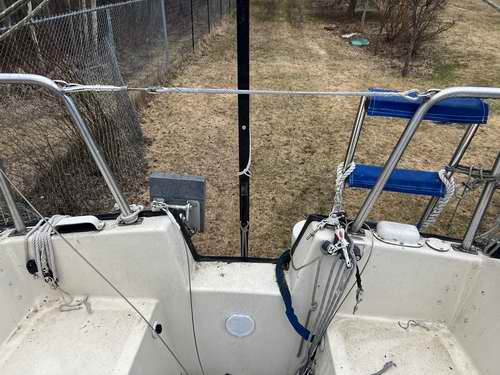
When the gate is open the pelican hook is clipped on the port pushpit to protect the cockpit gel coat from chafe. 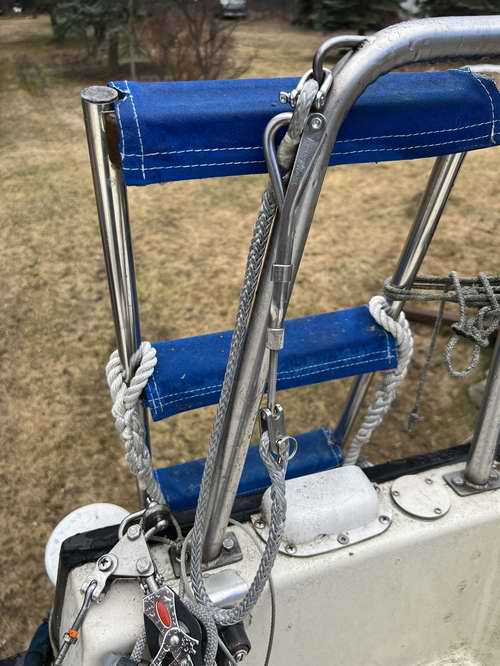
|
|
Transom Gate Parts
- Gate LOA = 33.5".
- 1 shackle.
- 42" of 6MM Dyneema = 26"+(2x8").
- 2 SS thimbles.
- 1 (RH) pelican hook e/w toggle.
|
| Panache Cockpit Gate - This side gate is closed when sailing, making me feel all warm and fuzzy to know I'm not going overboard. When open it lays in the trough next to the toe rail. This gate line will be turned end for end.

The cockpit gate and the forward lifelines were permanently attached to the stanchion at the front of the cockpit.
- The forward lifeline was always permanently tensioned when on the water and released only for winter storage.

|
Panache Cockpit Gate - This gate was reversed end for end with the aft end attached to the pushpit using a spliced eye and shackle as shown below.
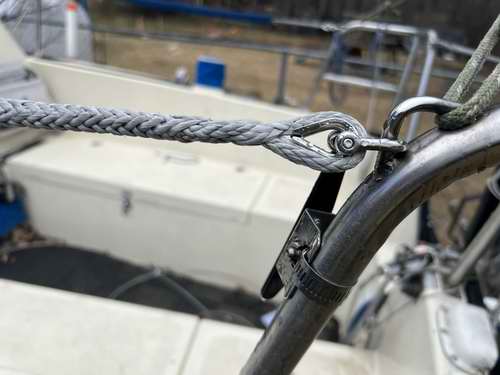
The pelican hook at the forward end of the gate is clipped to the stanchion eye at the front of the cockpit. The Dyneema spliced eye is pinned to the turnbuckle toggle screwed (LH) into the pelican hook. 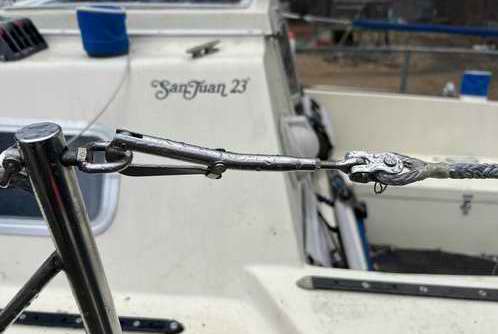
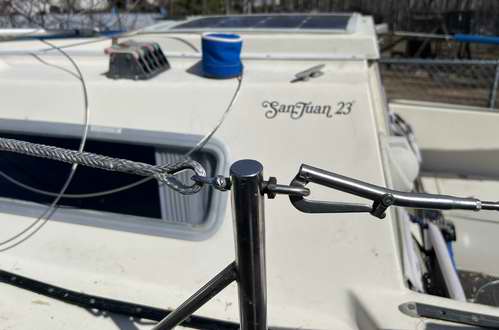
|
|
|
Cockpit Gate Parts (for port & starboard)
- Gate LOA = 66.5".
- 2 shackles.
- 150" of 6MM Dyneema = (2x59") +(4x8").
- 2 SS thimbles.
- 2 (LH) pelican hooks.
- 2 toggles.
|
Stanchions - All San Juan stanchions are hollow with an open bottom and a tube welded in the hole to pass the lifeline through. This means any water that enters to freeze drains out and can't split a tube. However, the finished edge of the lifeline hole is sharp enough to eventually cut through the Dyneema. This is why I inserted vinyl sleeves to protect the SS lifelines.
|
| Forward Stanchion - The SS line always passed through this post with a vinyl sleeve to protect it. It disappeared! The line also supported the lifeline net. 
|
Forward Stanchion - The lifeline is pulled through a split vinyl tube (ends bevelled inside) inserted through the mid stanchion. It also supports the lifeline net as before.
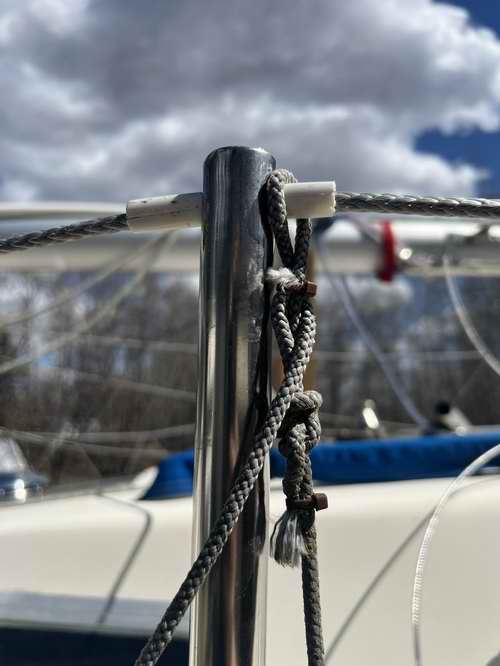
|
| Pulpit - These turnbuckles used to tension the SS lifelines. I have always installed them with the circlip pointed outwards to ease the abrasion against the jib.

|
Pulpit - The length of this lifeline was determined on the boat. It is fastened with Dyneema lashing between the pulpit and a SS eye spliced in the lifeline.
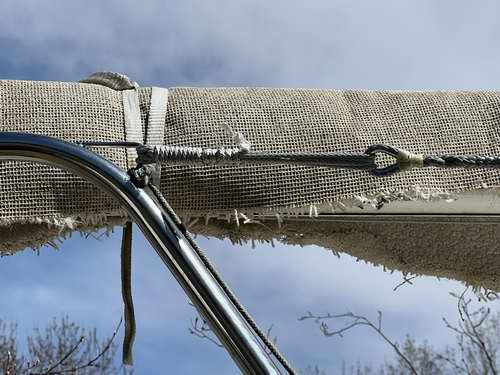
|
| |
Forward Lifeline Parts (for port & starboard)
- Lifeline LOA = ~102".
- 2 shackles.
- 244" of 6MM Dyneema = (2x102")+(4x10").
- 3M of 3MM Dyneema = 2(1.5M) of Lashing line.
- 4 SS thimbles.
- Two 3/8" vinyl inserts.
|
Total Parts - 10 SS 6MM thimbles, ~40' of 6MM (1/4") Dyneema line, 3 pelican hooks, 5 shackles.
|
If Dyneema isn't your cup of tea you could install solid stainless steel railing. Now that is something to experience.
|















